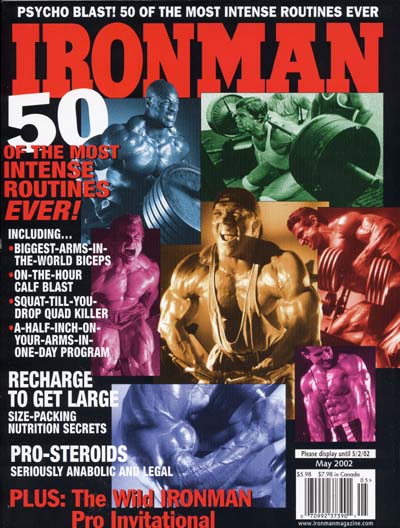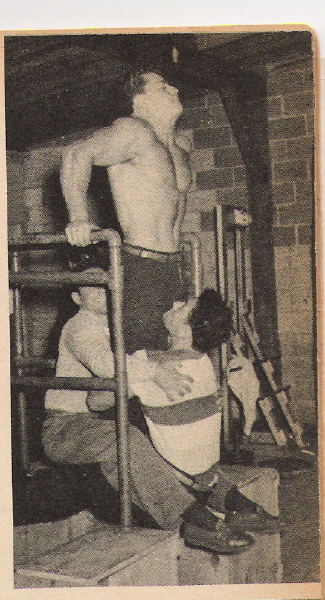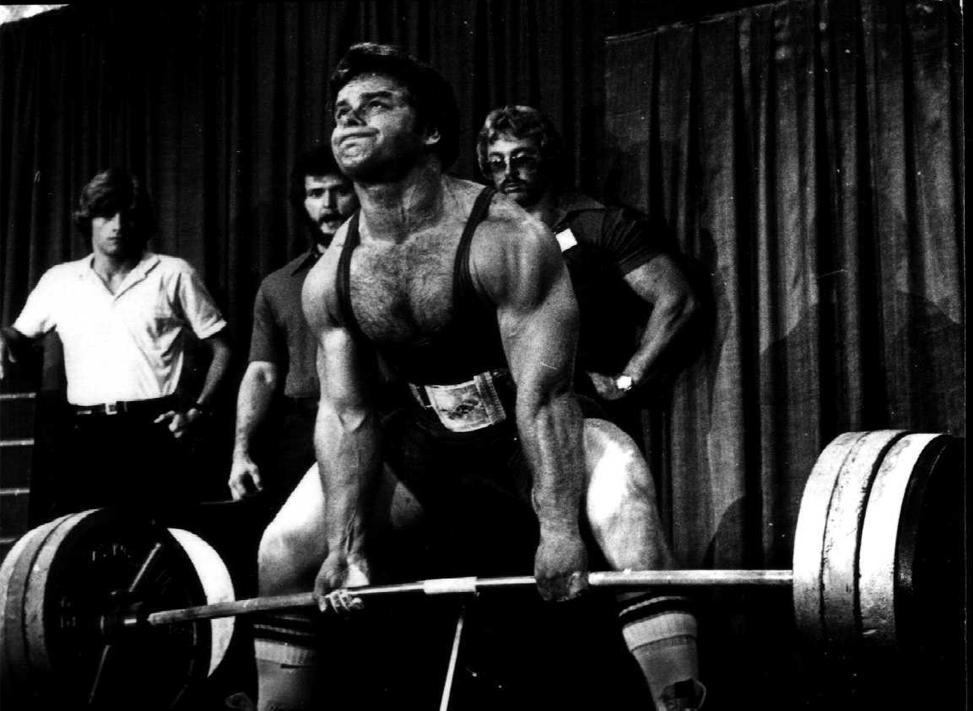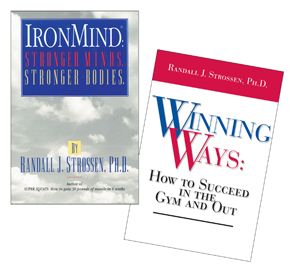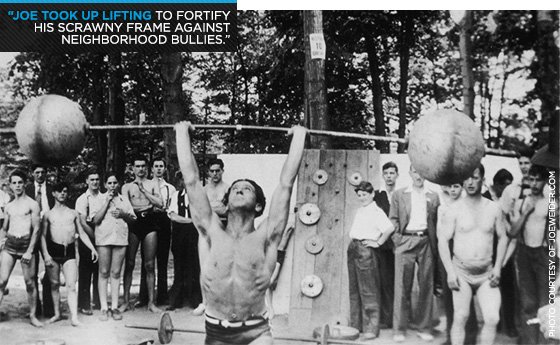Originally Published in This Issue (May, 2002)
RETRO MASS:
Full-Body Workouts for Muscle and Power
by C.S.Sloan (2002)
In the era of go-for-the-pump bodybuilding - the legacy of steroid using pro bodybuilders who are about as strong, pound for pound, as my 75-year old grandmother - we've forgotten one of the best methods for building bulk, mass, power and strength. I'm talking about the 3-Days a Week Full-Body Workout.
To be fair, it's not just pro bodybuilders who have brought about the near demise of this tremendously effective program. It's also the rantings of certain writers in the field, who'd have us believe that there's no way in hell we're going to grow if we train our bodyparts any more than once a week, or even once every other week. Well, I'm here to tell you that the 3-days-a-week method is still the best around for packing on power or busting out of a rut.
Not convinced? Take a look at these examples of bodybuilders and lifters who used 3-days-a-week full-body workouts.
Marvin Eder.
The greatest all-around bodybuilder, powerlifter and strength athlete ever to walk the planet, Eder had 19-inch arms at a bodyweight of 198. He could bench press 510, squat 550 for 10 reps and do a standing barbell press with 365. He was reported to have achieved the amazing feat of cranking out 1,000 dips in only 17 minutes. [60 x 17 = 1020 seconds/1,000 dips = averaging out to about one a second.]
As IronMan contributor Gene Mozee put it, "Modern day bodybuilders couldn't carry his gym bag." And no doubt about it, Eder's favorite routine for adding mass was a whole-body workout.
Steve Reeves.
Steve Reeves was renowned for the beauty and proportion of his physique. It was quite possibly the most perfect structure that ever graced a bodybuilding stage. He always used a three-days-a-week full-body routine. (And I bet you thought whole-body workouts were only for weightlifters).
The greatest all-around bodybuilder, powerlifter and strength athlete ever to walk the planet, Eder had 19-inch arms at a bodyweight of 198. He could bench press 510, squat 550 for 10 reps and do a standing barbell press with 365. He was reported to have achieved the amazing feat of cranking out 1,000 dips in only 17 minutes. [60 x 17 = 1020 seconds/1,000 dips = averaging out to about one a second.]
As IronMan contributor Gene Mozee put it, "Modern day bodybuilders couldn't carry his gym bag." And no doubt about it, Eder's favorite routine for adding mass was a whole-body workout.
Steve Reeves was renowned for the beauty and proportion of his physique. It was quite possibly the most perfect structure that ever graced a bodybuilding stage. He always used a three-days-a-week full-body routine. (And I bet you thought whole-body workouts were only for weightlifters).
Joseph Curtis (J.C.) Hise
In the 1930's J.C. Hise had been training for a number of years but weighed only 180 pounds at a height of 5'9". He was unsatisfied with his results until he took up a three-days-a-week workout built around heavy, high-rep breathing squats. Hise gained a then-unheard-of 29 pounds in one month. His results were so amazing that no one actually believed his progress.
Mike Bridges. Though perhaps unknown to many IRONMAN readers, Bridges was one of the greatest powerlifters of all time. Competing in both the 165- and 181-pound divisions, he benched well over 400 pounds, squatted more than 700 and deadlifted close to that. Bridges trained on all three of the lifts in the same workout, three days a week.
Still not convinced?
Just give the following routines a try, and I guarantee you'll be a believer.
Beginning-to-Intermediate Program
If you've never lifted a weight before - or you've only been lifting for a few months and your buddies at the gym have convinced you that a six-day split is the only way to go - it's time to take a true back-to-basics approach. If you've been lifting for years without making appreciable gains, that advice goes for you too.
What follows is very similar to the routine Marvin Eder used and recommended to other bodybuilders. Perform it on three nonconsecutive days during the week; for example, Monday / Wednesday / Friday.
Squat - 3 sets of 5 reps.
Use a medium-wide stance with the bar resting across your trapezius muscles. Make sure you lower to below parallel on the descent; that is , your hips should be below your knees. Also, stay tight at all times. Once you reach the proper depth, EXPLODE back to the top. Note that the above set and rep requirement doesn't include warmups.
Incline Barbell Press - 3 x 5 reps.
Use a bench set at 45 degrees. That will keep the focus on your chest muscles primarily, and save some shoulder strength for the overhead pressing later. Grip the bar so your little fingers are on the power rings, lower it to your upper chest - just below your neck - and then EXPLODE to lockout.
Wide-Grip Chin - 4 x failure.
Take a grip that's a good deal wider than shoulder width. As you raise yourself, try to come close to touching your chest to the bar. Descent slowly and focus on getting a good stretch in your lats. Perform four sets of as many reps as possible. I don't care if you can only manage two reps on your first set. Stick with the exercise until you're performing multiple reps on all four sets. You can alternate these with the incline presses if you wish: Do a set of incline presses, rest a couple of minutes and then perform a set of chins. Continue like that until all sets are finished.
Overhead Press - 3 x 6 reps.
Use as slightly wider than shoulder width grip and clean a barbell off the floor to your shoulders. Keeping your back straight, press the bar up to lockout. Lower, and then repeat. You only need clean the first rep, or you can take the bar from the rack or stands.
Standing Barbell Curl - 3 x 6
As popular as arm training is in modern gyms, it's a shame that you rarely see this exercise performed. Instead, pumpers and toners would rather spend their time doing numerous sets of cable, machine. or light dumbbell curls that never produce the results they're after. This exercise might be more taxing and painful than the others, but it's also the most effective.
Barbell Pullover and Press - 3 x 6
I don't give a damn if you've never heard of this exercise. It's fantastic for triceps mass and power as well as being an excellent finishing movement for the upper body. Lie on a bench and grab a barbell - preferably an EZ Curl bar to minimize wrist pain - holding it over your chest. Keep your upper arms locked into place and lower your elbows as if you were going to perform a skull crusher (lying triceps extension). Once your elbows are at 90 degrees, lower the bar back behind your head as if you were doing a pullover. Pull back up and press.
Here are some tips for getting the most out of this workout:
- After two weeks increase to four sets per exercise.
- After four weeks increase to five sets per exercise.
- After six weeks increase to six sets per exercise.
- Try to keep other exercise to a minimum.
- Don't add any exercises. The time for that will come later.
- Increase your weights whenever possible. Keep pushing to add more weight to the bar.
If you've been training for at least one solid year and have already made good gains, the time has come for you to move up to a more advanced workout.
Advanced Programs:
Using the Heavy, Light, and Medium Concept
When lifters reach the more advanced levels, they often switch to a split routine. Sometimes a split can be a good idea, but most of the time it isn't. Let's take a look at some advantages of whole-body workouts performed three days a week, for advanced lifters.
One advantage is that all the muscle groups get equal attention, which gives you proportionate strength throughout your body, and helps to focus on any weak bodypart. I know, I know. I can hear avid followers of the split routine objecting. That's the whole purpose of a split routine, right? To allow you to blast one or two bodyparts per day, giving them more rest between workouts and a greater pump at each session.
With most trainees, however, the split system does the opposite of what was intended. They tend to skip a lot of sessions involving the legs and/ore the trunk, meaning the hips, abs and lower back - and instead show up for more chest, shoulder or arm sessions. If, however, they resign themselves to performing squats and lower-back work at the beginning of each session - not allowing themselves to work any other muscle groups until their leg work is finished - they'll become much more balanced and symmetrical.
A lot of lifters use the excuse that they can't perform three full-body workouts a week because they just can't do justice to their other bodyparts if they train legs first. They say they're too tired to do any good work for the muscles of their chest and shoulder region, back or arms.
The reason for this is, they're out of shape. After a few weeks on a whole-body routine they'll have their strength back up to their previous levels on all bodyparts, and before long they'll have surpassed previous personal records.
Another advantage for advanced lifters is that their muscle groups get worked more frequently. Yes, I know what you're thinking. Haven't I advocated very infrequent training in the past? Sure - for lifters who have been grinding away for months or years on a multiple-set, multiple-rep, multiple exercise per bodypart, multiple days per week program. That type of training wreaks havoc on cortisol levels and depletes testosterone and recovery levels to such a degree that they require a bout of brief, infrequent training.
The opposite is also true, however. If bodybuilders have been performing infrequent workouts for an extended period of time, then an 8 to 12 week stint - or as long as the gains keep coming - of a three times per week full-body routine is in order.
Here's the kicker for advanced bodybuilders. You still hit each bodypart heavy only once a week. The other two full-body sessions are light and medium workouts.
Here's an example of the type of routine you should commit to when you graduate from the intermediate program.
Advanced Program One
Heavy Workout
Squat - 5 x 5, 1 x 10 reps.
Perform two warmup sets followed by three all-out sets of 5 reps. Pick a weight that you know you'll have to struggle to get the 5 reps with on all three sets. Whenever you manage 5 reps on all three sets add weight at the next workout. After the last set, drop the weight down for one set of 10 reps. These 10 reps should be next to impossible to perform.
Bench Press - 5 x 5, 1 x 10.
Follow the same plan as the squats.
Deadlift - 5 x 5.
Use the same plan as above, but omit the higher rep set.
Overhead Push Press - 5 x 8.
Do two warmup sets of 8 followed by three work sets, going as heavy as possible for 8 reps.
Barbell Curl - 5 x 8.
Incline Situp - 3 x 45.
Do these on an incline board. Perform 15 reps as regular situps, 15 reps twisting to the right side, and 15 reps twisting to the left side. For three sets.
Light Workout
Squat - 5 x 5.
Use a weight that's 60-65% of the weight you used in the heavy workout. In other words, if you squatted 300 pounds on Monday for your three work sets, you'd use about 180-195 pounds on these. You'll probably only need one warmup set so you can do the remaining four sets with your lighter work set weight. Concentrate on SPEED and EXPLOSIVENESS during these work sets. The concentric portion of each lift should go quickly.
Bench Press - 5 x 5.
Use the same plan as the squats.
Good Mornings - 5 x 5.
This exercise is great for building strong lumbars. Perform two warmup sets followed by three heavy sets of 5 reps. Heavy, of course, is relative on this exercise. Even though you're training intensely, you still won't be using anywhere near the amount of weight you used while deadlifting. Thus, it falls on the Light Day.
Seated Dumbbell Press - 5 x 8.
Do two warmup sets followed by three all-out work sets.
Concentration Curl - 5 x 8.
Crunch - 3 x 45.
Perform these as you did the incline situps on the Heavy Day. I put them on the Light Day because they involve a very small range of motion and don't require the effort that other ab work does.
Medium Workout
Squat - 5 x 5, 1 x 2 reps.
Perform two warmup sets just as you did on the Heavy Day, followed by 3 sets of 5 reps with a weight that's less than what you used at that workout. I like to use around 85% of what I use on the Heavy Day. For example, if you squatted 400 for 3 sets of 5 on the Heavy Day you'd use about 340 at this workout. After your 5th set rest a few minutes and then do a heavy double with more weight than you used on your Heavy Day. You might move up to 410 for these two reps. That will help you prepare for the upcoming Heavy Day, when you'll attempt the weight used for a double here on your 3 sets of 5.
Bench Press - 5 x 5, 1 x 2.
Use the same plan as just described for the squats above.
Stiff-Legged Deadlifts - 5 x 5.
Do two warmup sets of 5 followed by three heavy sets of 5. The weight you use on these should be somewhere between what you use on the Good Mornings on the Light Day and the Deadlifts on the Heavy Day.
Behind the Neck Press - 5 x 8.
Do two warmup sets followed by three heavy sets.
EZ-Bar Curl - 5 x 8.
Hanging Leg Raise - 3 x 45.
Perform one set while raising your legs straight up; one set while twisting your legs to the right side; and one set while twisting them to the left side.
Here are some tips to help you get the most out of this first advanced program.
- Stick with the program for at least 8 weeks.
- Make sure you eat adequate amounts of protein. This program is very demanding, and you'll need extra nutrients. If you're trying to add as much muscle mass as possible, get somewhere between 15 and 20 times your bodyweight in calories on a daily basis.
- After a month on this program increase the amount of weight you use on the light and medium days. Go to 75% on the Light Day, and 90% on the Medium Day.
Advanced Program Two
This routine is for very advanced lifters who have been training for at least two years, are in excellent condition, and have reached the upper limits on their numbers on the big lifts like the squat, bench, and deadlift. It incorporates the Heavy / Light / Medium system, but goes about it differently from the first program.
In this routine you perform different lifts on each day, and the exercise itself determines what day it falls on.
Keep in mind that what follows is just an example. Highly advanced lifters need to incorporate as much variety as possible. Feel free to change exercises on the light and medium days regularly as long as they fall within the guidelines.
Heavy Day
Squat - 7 sets of 5 reps.
Don't deviate from the instructions for this exercise; no matter what. The full squat, or some version of it, should be the cornerstone of every workout in every routine. There, however, you do two more sets than you did previously. Perform three progressively heavier warmup sets followed by four work sets of 5 reps. Once you can get 5 reps on all four work sets increase the weight on the next Heavy Day.
Bench Press - 7 x 5.
Use the same plan as the squats above.
Deadlift - 7 x 5.
Not the same as it ever was, but the same as above.
Alternate:
Wide-Grip Dips and
Wide-Grip Chins - both 4 x 5.
You should be well warmed up from the previous work, so jump straight into your work sets on these. Perform a set of dips, rest two minutes, then do a set of chins, rest another two minutes, and continue back and forth until you complete all eight sets, four sets of each.
Alternate:
Barbell Curl and
Pullover and Press - both 4 x 5.
As above. As above, so below.
Incline Situp - 3 x 60.
Use the same plan as described for the Heavy Day in Advanced Workout One. Here you go for 20 reps in each direction.
Light Day
Olympic-Style Pause Squat - 5 x 5.
Perform these with the bar resting high on your traps, almost on the neck.
Use a fairly close stance and squat as low as possible, pausing at the bottom for a second before starting the ascent. Perform two warmup sets. Shoot for a weight that's at least 70% of what you use on the work sets for your squats in the heavy workout.
One-Arm Dumbbell Bench Press - 5 x 5.
This exercise will be tough when you first try it, because of the coordination it takes to lift heavy weight with just one arm. Stick with it, however, as it will greatly aid your regular bench press. Do five sets with each arm.
Round Back Good Morning - 5 x 8.
I reserve this exercise for advanced lifters who are already used to working regular good mornings intensely. The rounding of the back will enable you to go much deeper on the negative portion and work the lower back in a different manner. Be cautious when increasing the poundage.
Superset:
Dumbbell Curl and
Lying Triceps Extension - 5 x 8 each.
Crunch - 3 x 60.
Medium Day
Bottom-Position Squat - 5 x 3, 1 x 3 reps.
Set the pins in the power rack below parallel.This exercise will bring new meaning to the words Hard Work if you've never performed it before. It is, in fact, a tougher exercise than a regular squat due to the amount of effort it takes to start the squat off the pins in the rack from a bottom position. The fact that you aren't able to use as much weight is the reason this exercise falls on the medium day. You should do the final set of three reps with a weight that's close to your work weight on the Heavy Day . . . once you become accustomed to the dead start of bottom-position squatting.
Incline Bench Press - 5 x 5.
Do two warmup sets of 5 reps followed by three work sets. The weight should be approximately 90% of the weight you use on the flat bench presses.
Power Clean - 5 x5.
This is one of the best back exercises in existence. The beauty of it is that you can work your lower, middle, and upper back all in one exercise, once you're working it hard enough. If you've been lifting for more than a couple of years and have never tried these, you've done yourself a real disservice. They're not that easy for rank beginners to learn, and this is the reason I've included them in the advanced program.
Close-Grip Chin - 5 x 5.
Use a regular, reverse grip on these. Use the same weight as you use on the wide-grip chins on the Heavy Day.
Lying Barbell Triceps Extension - 5 x 5.
Hanging Leg Raise - 3 x 60.
Here are some tips for getting the most out of the program:
- Remember, the workout is only a guideline. The more advanced you become, the more variety you'll need. There are many chest, back, and squatting exercises to rotate, so you should never go stale on the program. With a little thought and lifting experience on the exercises, you will be able to determine which ones fit the Heavy, Light, and Medium days naturally.
- Take in a large amount of protein while you're on the program, but don't be ridiculous. You should be training hard at every session with this routine, so your body will need extra nutrients.
- If you feel worn out, avoid taking a layoff at first. Simply switch to some exercises that require the use of lighter weights for a week or two. That will decrease your total workload and should get you back on the gaining track, back in the saddle, trains now leaving once more.
Final Thoughts
Being of sound mind I do hereby leave my, no, not that. If you've never tried full-body workouts before, you owe it to yourself and your muscles to give them a try. Some people would call them a little retro, but in my book that ain't a bad thing.
Show the world some workouts that Marvin Eder, Steve Reeves, and J.C. Hise would be proud of!
